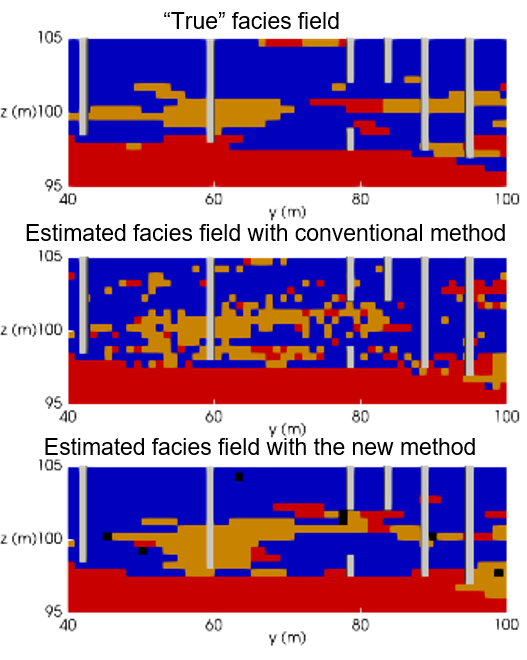Creating better models to predict subsurface water flow and transport
New framework improves the predictions of subsurface sediment permeability

The Science
Co-authors of a paper in Water Resources Research led by PNNL researchers developed a new iterative data assimilation framework to more accurately describe the permeability of subsurface sediments in numerical models when using facies, a system that classifies dissimilar sediments into distinct geological units that share important features of interest to modelers. The iterative framework applies data from field observations and experiments to inform the delineation of facies at the start of each model run. Further refinements are achieved at each iteration through the application of statistical constraints that maintain geologic continuity among adjacent locations.

The Impact
Spatial distribution of three facies (red, yellow and blue colors) in a 2D vertical cross section of a 3D case. Figures show the new method provides a more accurate and continuous estimation of facies distribution compared to the conventional method. White colors in the figures are bore samples and black dots are the conditioning points selected by the new method.
More realistic numerical representations of the permeability of subsurface sediments lead to improved predictions of groundwater flow and the concentration of constituents that are transported with the flow. The data assimilation framework can also be applied to estimate other subsurface properties from field measurements, or from data from other systems such as watersheds, as long as they can be categorized into a few discrete representative units.
Summary
Observational data on subsurface permeability is limited for most watersheds because of the impracticality of digging enough boreholes or wells to capture the heterogeneous nature of the subsurface environment. To solve for this limitation, researchers have widely adopted approaches that estimate permeability from field experiments such as a) measuring how water levels at a cluster of wells change when water is pumped at a nearby well, or b) monitoring how quickly a tracer released at one well reaches other wells in the aquifer. The U.S. Department of Energy’s Hanford 300 Area Integrated Field Research Challenge site, for example, is well characterized from data assimilation methods that were used to understand the long-term persistence of nuclear fuel fabrication wastes disposal from 1943 to 1975.
The use of a facies approach to segment the subsurface reduces complexity in numerical models by grouping heterogeneous sediments into distinct homogenous units defined by hydraulic, physical and or chemical properties. A major difficulty with existing facies-based approaches in numerical models is that each facies is treated as its own, independent unit. Therefore, these models fail to capture the spatial continuity of subsurface sediments. The authors of this paper developed a framework that maintains continuity between neighboring facies in numerical models and thus better reflects true subsurface geology, and thereby groundwater movement. The improvements come from an iterative data assimilation approach that incorporates direct and indirect data about subsurface permeability gathered from field observations and experiments at the start of each model run as well as the application of statistical constraints about subsurface geology. The data assimilation and statistical constraint steps are re-imposed for each iteration, leading to refined facies delineation. This framework reduces uncertainty about the spatial distribution of sediment types in the subsurface, which results in more accurate predictions of groundwater flow and constituent transport.
The authors evaluated the performance of the new framework on a two-dimensional, two-facies model and a three-dimensional, three-facies model of DOE’s well-characterized Hanford 300 Area that were conceptualized from borehole and field tracer experiments. The results of the research shows that the framework can identify facies spatial patterns and reproduce tracer breakthrough curves with much improved accuracy over facies-based approaches that lack spatial continuity constraints. With additional data, the authors say that the framework can also be used to categorize biogeochemical reactive units in an aquifer.
Contact
Xingyuan Chen, Earth Scientist, Xingyuan.Chen@pnnl.gov
Funding
Funding for this research came from DOE Office of Science BER, PNNL Subsurface Biogeochemical Research SFA.
Revised: February 17, 2020 | Published: February 19, 2020
Song, X., Chen, X., Ye, M., Dai, Z., Hammond, G., And Zachara, J.M. (2019). Delineating facies spatial distribution by integrating ensemble data assimilation and Indicator Geostatistics with level-set transformation. Water Resources Research, 55. https://doi.org/10.1029/2018WR023262